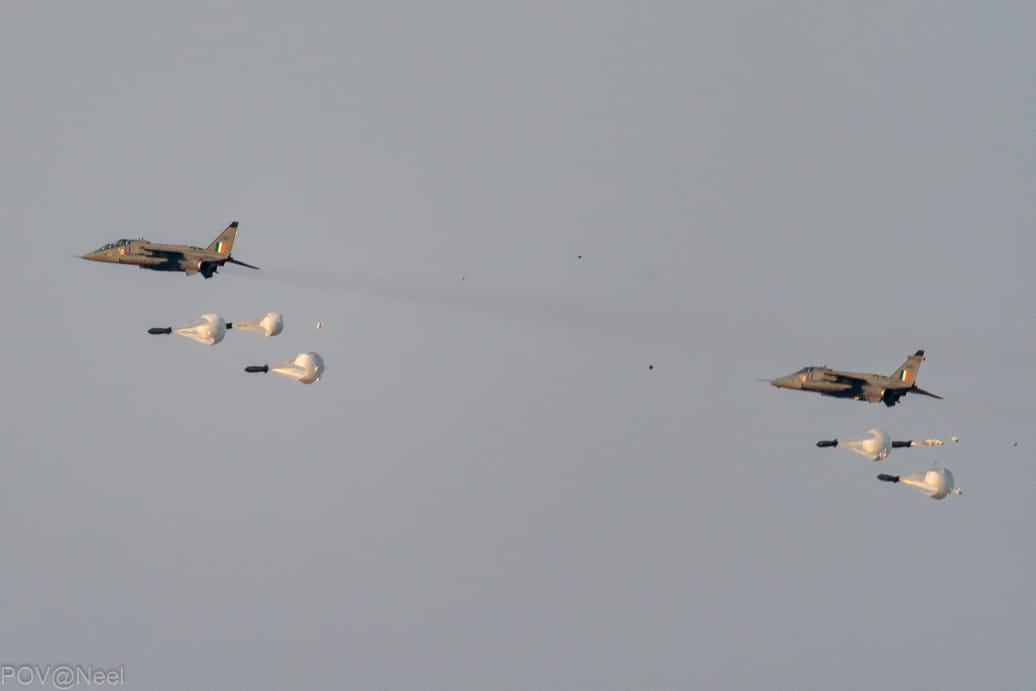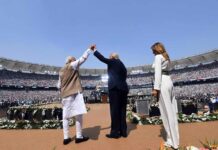Well before the Pulwama attack, I had been stating in multiple articles, that there would be a terrorist strike close to elections. It had to happen, as Pak was desperate to create an internal environment, within India, which could impact the result of the elections. They would prefer a weak coalition, rather than a strong single party led government, which can act decisively.
It was aware that India would react to a terrorist strike and this time they would be prepared. The Pulwama attack, though claimed by the Jaish-e-Mohammed had the backing and support of the ISI and Pak army. Evidently, Masood Azar remains only a figurehead, the individual to take credit and be the fall guy. Even if he is declared an international terrorist, nothing would change. Hafiz Saeed has a USD 10 Million bounty, but remains free in every way, protected by the deep state.
The true approvers and financers of terror are the ISI and the Pak army. Terrorist camps are run by them, trainers are ISI personnel and it is the army which protects their top leaders, as also ensures infiltration of terrorists. This is borne by the fact that the Pak army was prepared and deployed well before India even cremated its casualties, expecting an Indian retaliation. It was aware of the timing of the strike and had prepared for Indian response.
The Pulwama terrorist attack and Indian response has changed Indo-Pak equations for a long time. The car borne suicide attack, the first by a local Kashmiri in a long time, and the quantum of casualties shook the nation. The modus operandi of the suicide attack will enhance security concerns in the valley. It will change operating procedures in multiple ways. Movement by air and upgrading risk levels for CAPFs has already been sanctioned by the Home Minister. Changes in convoy procedure have been implemented. Intelligence lapses are being studied and necessary modifications would be implemented.
The government in retaliation initially launched its economic and diplomatic offensive, seeking to push Pak into a corner and isolate it. Its removal from the list of MFN and placing a duty of 200% on imports had an immediate impact. Demands for Pak goods dropped. India also announced utilizing entire water resources allocated to it under the Indus water treaty, adding to problems for water scarce Pakistan. Simultaneously, the diplomatic offensive was launched. While the world supported India and was willing to back its offensive actions as a counter, it did little to push Pak.
Pak continues to occupy centre stage due to its geopolitical location. The US and NATO nations need its support to continue talks with the Taliban. Taking cue of this advantage, Pak’s ambassador to Afghanistan threatened that talks would be impacted, if India launched any military action. China needs Pak to protect its investments and to counterbalance India, hence would do little. Russia, though criticised the strike, maintained a quiet distance as it is also keen to maintain ties with the Taliban and hence with Pak.
A military retribution was on the cards. For the nation, diplomatic and economic measures imply nothing. They desire blood. The government had launched a shallow offensive strike across the LoC, post the Uri attack. However, while it did shake the Pak politico-military establishment, it did little to curb them, as the Pak army successfully manipulated its controlled media and ensured that the truth was denied to its public. Eliminated terrorists were cannon fodder, whocan be recreated. This successful tactical operation seeking strategic gains, satisfied the Indian public, but had limited impact in Pak.
Pak had expected the Indian government to repeat a similar strike hoping its nuclear blackmail would hold back Indian application of force. Use of air power is an indicator of escalation, which till date India had avoided, hence Pak remained confident of the same this time around too. Even during the height of the Kargil war, Vajpayee had denied permission to the air force to cross the LoC. Pak was prepared for a ground action. It failed to realize that terrain conditions at this time did not suit a ground operation.
Also Read: Strategies To Mitigate And Resolve Unemployment In India
The government decision to take the aerial route was a major shift in strategy. The selection of the target in depth, beyond disputed POK implied determination and seriousness. It conveyed important messages. For the international community it was that Indian patience has been tested and it would act, willing to call the Pak nuclear bluff. It called on the international community to reign in Pak and support the Indian stance.
For Pakistan, it meant that India will escalate, ignoring the nuclear card. Threats imply nothing. Reign in your terrorists or face the Indian military power. For the Indian public, it was clearly aimed at sending forth the message that India has retaliated, harder than the last time. The selection of the target was also specific. There were to be no civilian or military casualties as only the terrorist camp, isolated from the local population would be hit. Pak cannot admit its existence, hence would be compelled to resort to a cover-up. The terrorists are cannon fodder while the location has been shared with Pak as a terrorist hideout multiple times. Hence, if Pak must retaliate, it needs to carefully calibrate its response.
The success of the strike was evident. The Pak air force could not even be airborne before the aircraft were back on Indian soil. The target was cleanly hit, with every building marked for destruction, destroyed. The Pak DG ISPR only admitted Indian aircraft crossing the LoC.Pak again hid facts from its public, despite many Pak nationals within and abroad aware of the true level of destruction. Their press is aware but too scared to comment.
Also Read: Bringing Businesses Back On Track, Govt Must Heed To Gadkari’s Advice
Pak retaliation came shortly. It launched a daylight raid, which was a hurried action, only to satisfy its population. It did attempt to hit military targets (India has no terrorist camps on its soil) but failed. In the ensuing dogfight, both nations lost an aircraft each, with Pak losing an F16 to an Indian MIG21 BISON. The only plus point was the capture of the Indian pilot, who ejected into POK and has since been repatriated. Pak still needs to admit the loss of its pilot and aircraft. Pak has made no mention of the failure of its air defence network as also of the incapability of its air power, which failed to stop Indian ingress.
Simultaneously, the Indian army activated the LoC and engaged Pak’s military positions. Twitter handles from POK lamented the rising casualties and even projected shortage of blood in hospitals. The message has clearly gone home.
The airstrike rattled Pak’s top leadership. Pak is presently in a precarious position. Financially and militarily it is weak. It is aware that India has shut the door on the only card which it possessed to hold India back, its nuclear threat.
Anti-India Obsession, Debt Among Reasons For a ‘Failing Naya Pakistan’
It is further aware that Indian mobilization will not impact the Indian economy but may shatter theirs. If it withdraws soldiers from Baluchistan, the situation may deteriorate to the level that it would take long to regain control. A blockade of Karachi can break Pak in multiple ways. Therefore, all cards are in Indian hands, Pak being a mere spectator. It hence began talking peace and rapidly announced the repatriation of the Indian pilot, Wing Commander Abhinandan. The remarks by the Indian air chief in a press conference that the operation was ongoing further worried Pakistan.
While the Pak military may hide facts on true casualties, the Indian polity may battle on casualty figures and the strike becomes the main plank of the 2019 elections, there is no denial that very few nations have ever responded with such precise force on a nuclear- powered adversary. Israel attacks Hamas fighters who possess rudimentary weapons or Iranian targets in Syria and US attacks nations which cannot respond or terrorist targets in Afghanistan, Syria or Africa. Such a strong response has rarely been done and with such precision.
While Indian military power has proved its mettle, the political leadership needs to be given due credit. Taking such a decision is fraught with major risks. Failure of the operation, casualties to Indian aircraft or hitting civilian or military targets would imply placing the ball in Pak’s court. India would have come in for international criticism and it would have had severe impact on domestic politics, especially as elections are around the corner. Luckily, Pak danced to Indian tunes and denied any civilian casualties.
The political battle for a count of casualties is a low point in our polity. The intention of the strike was not to seek numbers of dead, but to convey the message of Indian military power, determination and its willingness to call the nuclear bluff. The closing of Pak airspace for days after the strike, indicates that the message was conveyed, and panic had set in within its top hierarchy.
This raises the question of whether this one action would change Pak’s outlook? The answer is very unlikely. Pak can neither curb terrorist activities, nor shut them down. The radicalized Pak army cannot be suddenly told to change tack. Any such action could lead to militants joining the TTP and adding to Pak problems. Hence, internally Pak would remain the same, unless the cost is made prohibitive. This cost may not completely flow from a military operation. It would need to be economic, rather than military alone.
Hence, while military threat remains and India continues to talk of escalation, economic offensives must commence, with diplomatic push. Restricting nations from funding Pak’s economy, application of pressure on IMF to place severe controls on Pak’s defence expenditure and continuous pressure on FATF to maintain Pak on the Grey List or even shift it to the Black List should be on the agenda. China alone cannot support Pak for eternity. It may soon realize that unless Pak changes, its own investments remain at risk.
India should begin to provide diplomatic support to the Baluch’s as they fight for freedom. Human rights abuses there should be projected,and Pak embarrassed in the international environment. Joining hands with Iran to target Pak would only add to their concerns. India must employ its complete national power to bring about a change in Pak’s policies. Only application of military power would never have the desired impact.
The target should be the Pak army, as it controls Jihadi groups. Unless it is shamed and its vulnerability displayed to its public, nothing will change. The recent Indian action has had little success in this regard, as the Pak army hid facts from its public. It could manage this as it controls their press and polity. Pak may remain cautious for some time but would soon raise its ugly head and attempt another terrorist action. This cycle would continue unless India evolves a ‘whole of government’ approach to tackle Pakistan.
Disclaimer: The information, ideas or opinions appearing in this article are those of the author and do not necessarily reflect the views of N4M Media.



















